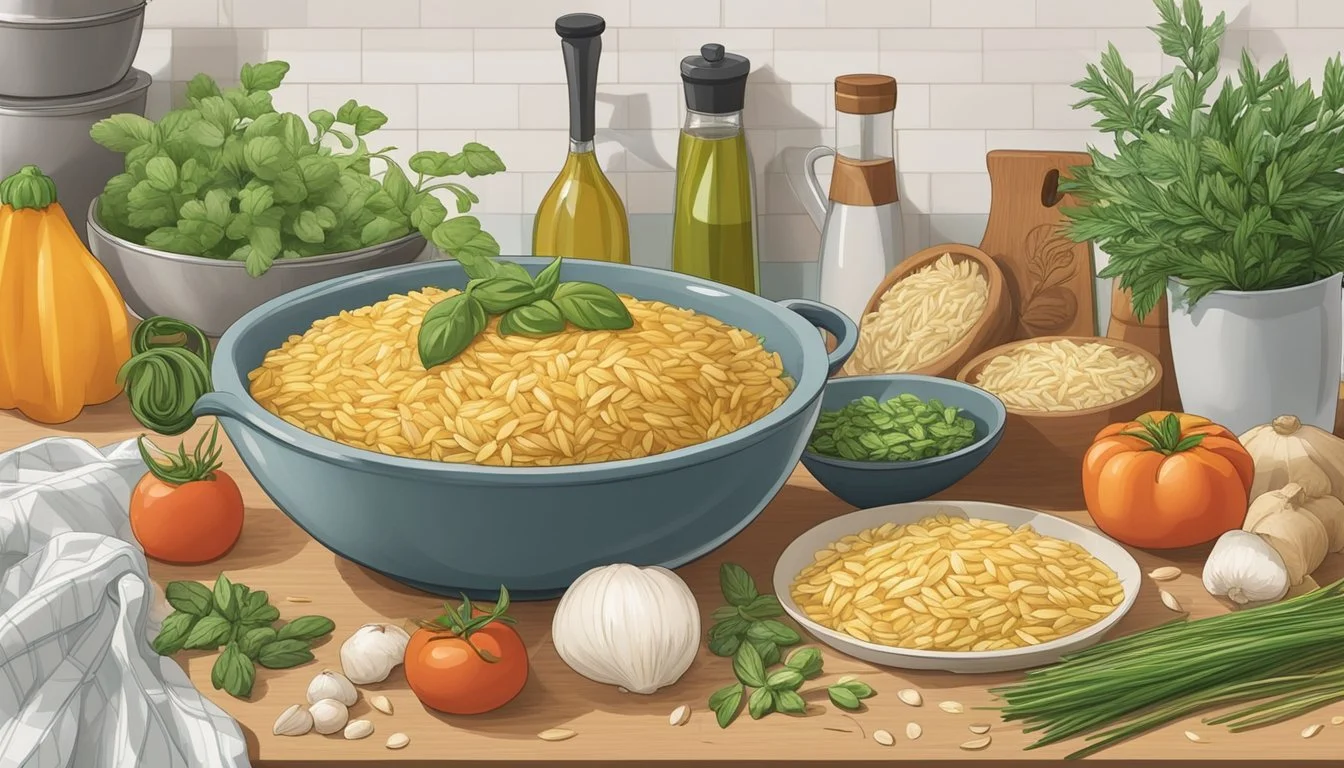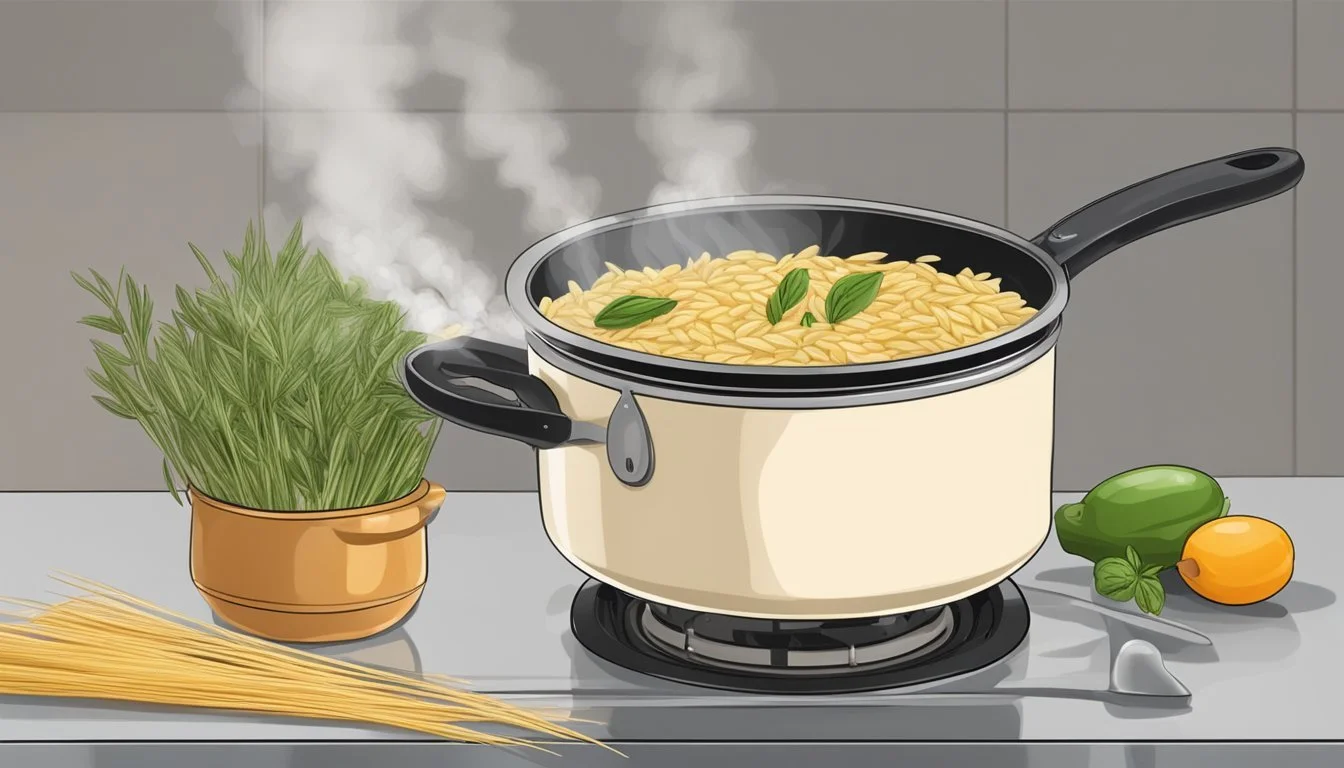How Long Do Orzo Last?
Shelf Life and Storage Tips
Orzo, often regarded as a form of pasta (What wine goes well with pasta?) that resembles rice, is a versatile ingredient that is commonly used in a myriad of dishes, ranging from salads (What wine goes well with salads?) to soups to casseroles. Much like other kinds of pasta, orzo's shelf life varies depending on its storage forms—either dry or cooked. Dry orzo, when stored properly at room temperature in a tightly sealed container away from moisture and heat, can maintain its quality for approximately three years. The longevity of dry orzo is influenced by certain factors such as the brand, packaging materials, and the storage environment.
Once cooked, orzo takes on a different storage profile. It can be kept in the refrigerator where it remains safe to consume generally for three to five days. It is crucial to store it in an airtight container to avoid contamination and moisture, which can accelerate spoilage. Cooked orzo should be consumed within the advisable timeframe not only to enjoy its taste but also to ensure food safety, as bacteria grow rapidly at temperatures between 40°F and 140°F. If cooked orzo is left out at room temperature for more than two hours, it is deemed no longer safe to eat.
In both dry and cooked states, orzo exhibits characteristics common to pasta and rice regarding storage and shelf life. Its durability at room temperature as a dry product makes it a pantry staple, while as a cooked commodity, it requires refrigeration and timely consumption. The key to maximizing orzo's shelf life and maintaining its quality lies in proper storage methods and awareness of its perishability once prepared.
What Is Orzo?
Orzo is a form of short-cut pasta, which bears a striking resemblance to a grain of rice. Despite its rice-like appearance, it is made from semolina flour (how long does semolina flour last?) that comes from durum wheat, making it a true pasta. For those with gluten sensitivities, orzo may not be suitable as it contains gluten, a protein found in wheat.
Appearance: Looks similar to rice.
Composition: Made from semolina, which is derived from durum wheat.
Gluten Content: Contains gluten.
Traditionally found in Mediterranean dishes, orzo has a versatile nature that allows it to be incorporated into a wide array of recipes including salads, soups, and casseroles. It does not have a flavor of its own, but rather, it tends to absorb the flavors of the other ingredients it’s paired with.
In its uncooked form, orzo should not be confused with barley, which is a different grain, despite the fact that 'orzo' also means 'barley' in Italian. When cooked, orzo expands slightly but maintains its distinct shape and texture, often described as al dente, just like any other type of pasta when prepared properly.
To prepare orzo, one typically boils it in salted water for approximately 8 to 10 minutes but should always refer to the package instructions for precise cooking times. Once cooked, it can be enjoyed in its simple form or embellished with complementary ingredients like butter or olive oil to enhance its taste.
Orzo Nutritional Profile
Orzo, a type of pasta shaped like rice grains, is a versatile ingredient often used in a variety of dishes. Its nutritional content is a consideration for those monitoring their diet.
Calories and Nutritional Values
Orzo contains approximately 210 calories per serving. A typical serving size is around 2 ounces (56 grams) of dry orzo, which, when cooked, expands to about a cup. Here is a breakdown of the primary nutritional values in a single serving of orzo:
Calories: 210
Fat: 1g
Sodium: 0mg
Carbohydrates: 41g
Dietary Fiber: 2g
Sugars: 2g
Protein: 7g
These values are important for individuals aiming to balance their intake of proteins, carbohydrates, and fats.
Gluten Content in Orzo
Orzo is traditionally made from wheat flour, which means it contains gluten. This makes it unsuitable for those with celiac disease or a gluten intolerance. However, there are gluten-free alternatives available, which are made using corn flour (how long does corn flour last?), rice flour (how long does rice flour last?), or a blend of gluten-free flours. Consumers seeking a gluten-free option should explicitly look for labels stating the orzo is gluten-free.
Proper Storage of Orzo
Proper storage of orzo is crucial to maintain its quality and extend its shelf life. This section outlines specific methods for storing dry orzo, refrigerating cooked orzo, freezing, and determining shelf life indicators.
Storing Dry Orzo
Dry orzo should be kept in an airtight container to protect it from moisture and pests. Storage should be in a cool, dry place such as a pantry or cupboard, away from direct sunlight and heat sources. Under optimal conditions, dry orzo can maintain its best quality for up to three years at room temperature.
Refrigerating Cooked Orzo
Once cooked, orzo should be cooled to room temperature and then stored in the refrigerator within two hours to minimize the risk of bacterial growth. Place the cooked orzo in an airtight container or a tightly sealed plastic bag. It’s recommended to label the container with the date of storage. Cooked orzo can last in the fridge for 3-5 days.
Freezing Orzo
Orzo can also be frozen to extend its usability beyond the refrigerator shelf life. To freeze cooked orzo, one should let it cool completely, divide it into portion sizes, and place it in airtight containers or freezer-safe bags. When stored properly, frozen orzo can last for 1-2 months. Thaw it in the refrigerator overnight before reheating.
Shelf Life Indicators
To assess whether orzo is still good to eat, look for changes in texture, color, or smell. Dry orzo that has an off smell or shows visible signs of mold should be discarded. For cooked orzo, any sour or unpleasant odors, slimy texture, or discoloration are indicators that it has spoiled and should not be consumed. Always check stored orzo before use and ensure that storage conditions are consistently maintained for optimal shelf life.
Cooking Techniques for Orzo
Cooking orzo properly is essential for achieving the best texture and flavor, whether it's for soups, salads, or as a side dish. Understanding the correct techniques can significantly enhance this versatile pasta's role in various recipes.
Boiling Method
Orzo can be boiled much like any other pasta. A standard approach involves:
Bringing a large pot of salted water to a boil.
Adding the orzo and stirring occasionally to prevent sticking.
Cooking for about 8-10 minutes or until it reaches an al dente texture.
Draining the orzo in a colander after cooking.
Tip: Adding a tablespoon of olive oil to the boiling water can help reduce stickiness.
Risotto Style
Orzo can also be cooked in a risotto style, which helps to release its starches and results in a creamier dish. The steps are:
Melt butter or heat oil in a pan over medium heat.
Add the orzo, toasting it until it becomes golden brown, which usually takes about 3-5 minutes.
Pour broth gradually, stirring continuously for even absorption and to avoid clumps.
Cook until all the liquid is absorbed and orzo is tender yet firm.
Tip: One can enhance the flavor by sautéeing diced onions before adding the orzo.
Incorporating into Soups and Casseroles
Adding orzo to soups and casseroles brings a satisfying texture and helps to thicken the dish. To incorporate orzo effectively:
For soups, add the orzo in the last 10 minutes of cooking to avoid overcooking.
For casseroles, mix the orzo in with the other ingredients and bake as directed. The orzo will cook in the oven's heat and absorb flavors from the dish.
Tip: Precooking orzo before adding it to casseroles is not typically necessary, as it cooks in the liquid from the recipe.
Orzo Culinary Applications
Orzo, a versatile pasta, shines across a variety of culinary applications, from refreshing salads to hearty main dishes, with its rice-like shape making it a unique complement to various ingredients.
Salads and Side Dishes
Orzo is a staple ingredient in salads and side dishes. It serves as an excellent base for pasta salads, often tossed with a vibrant dressing, fresh vegetables, and herbs. In a salad, orzo pairs well with a medley of seasoning, forming a dish that can be served either chilled or at room temperature. For side dishes, orzo can be incorporated into a risotto-style preparation, cooked slowly with broth and stirred continuously to a creamy consistency, often finished with a pat of butter or cheese for richness.
Recipe Example for Orzo Salad:
Cook orzo according to package instructions
Mix with diced cucumbers, cherry tomatoes, and olives
Toss with a lemon-olive oil dressing and season with salt and pepper
Main Course Utilization
Orzo is equally robust as a main dish component, particularly when paired with meat. Cooking orzo in a soup brings a satisfying texture and helps to thicken the broth. It's also used as a base beneath protein, like grilled chicken or fish, absorbing any sauces or juices they release. Orzo can be used to prepare a hearty main course akin to a pilaf, sautéed with onions and garlic, and cooked in a flavorful broth. Chefs may finish the dish with herbs or grated cheese, enhancing its flavors and making it a complete meal on its own.
Recipe Example for Orzo Main Course:
Brown pieces of meat in a pan and set aside
Sauté onions and garlic, then add orzo to toast slightly
Return meat to the pan, cover with stock, and simmer until fully cooked
Preserving Orzo's Quality
Proper storage methods are crucial for maintaining the best quality of orzo in terms of texture, flavor, and appearance. These methods not only extend the shelf life of the pasta but also protect it from spoilage and degradation.
Avoiding Spoilage
To prevent orzo from becoming spoiled, one should always store the pasta in a cool, dry place away from moisture, which can promote mold growth. It is important to keep orzo in an airtight container to protect it from contaminants and preserve its quality. Once cooked, orzo should be refrigerated within two hours, as room temperature allows bacteria to thrive, which can lead to spoilage.
Uncooked Orzo:
Best quality for approximately 3 years at room temperature.
Airtight container is essential to avoid spoilage.
Cooked Orzo:
Refrigerate in shallow airtight containers or resealable plastic bags.
Consume within 1-2 months when frozen to maintain quality.
Assessing Orzo Quality
One can assess the quality of orzo by examining its appearance and odor. If one notices any off odors, changes in color, or signs of mold, it indicates that the orzo has gone bad and should not be consumed. The texture should be firm and not too soft; any noticeable change could be a sign of diminishing quality.
Signs of Spoiled Orzo:
Mold presence.
Off or sour odors.
Changes in texture and color.
By following these guidelines, one can ensure that their orzo remains of the highest quality for as long as possible, allowing them to enjoy the pasta’s intended flavor and texture.
Reheating and Serving Orzo
When it comes to leftover orzo, one can reheat it to restore its texture and flavor before serving. The process is straightforward, whether one uses an oven or microwave.
Methodology for Reheating
Oven Method:
Preheat the oven to 350°F (175°C).
Place orzo in an oven-safe dish.
Add a tablespoon of water or broth per cup of orzo to maintain moisture.
Cover the dish with aluminum foil to keep the moisture in.
Heat for 15-20 minutes until thoroughly warmed.
Microwave Method:
Transfer the orzo to a microwave-safe container.
For every cup of orzo, stir in a tablespoon of water or broth.
Cover the container with a microwave-safe lid or plastic wrap, allowing a corner to vent.
Microwave on high for 1-2 minutes, stirring halfway through to ensure even heating.
If necessary, additional time can be added in 30-second increments until the desired temperature is reached.
Serving Suggestions
For Hot Orzo:
Serve reheated orzo immediately for the best texture and taste.
Add fresh herbs or grated cheese to enhance flavor.
For Cold Orzo:
Rinse the orzo under cold water to prevent it from sticking and to cool it down if serving as a salad.
Combine with fresh vegetables, a vinaigrette dressing, and proteins such as chicken, shrimp, or cheese for a well-rounded meal.
Creative Uses and Recipes
Orzo, a versatile pasta shaped like rice, can be used across a wide range of dishes. It's often used to add substance to salads, serves as a base for pilaf-style recipes, and can be incorporated into soup or stuffed into vegetables.
Recipe Ideas for Orzo
Orzo stands out in its ability to pair well with a variety of ingredients, making it perfect for diverse pasta recipes. Here are some creative ways to use orzo:
Salads: A simple orzo salad can be made by tossing cooked orzo with cherry tomatoes, cucumber, feta cheese, and a vinaigrette.
Pilaf: Orzo can be browned in butter and then cooked with broth to create a flavorful pilaf. One can enhance the dish by adding sautéed onions, garlic, and herbs.
Stuffed Peppers: Combine cooked orzo with Italian sausage, spices, and cheese to fill bell peppers for a baked entrée that's both hearty and aesthetically appealing.
For those with a preference for a cheesy touch, an orzo "risotto" can offer a creamy textural experience. Incorporate cheese and herbs into the cooked pasta until it reaches a risotto-like consistency.
Gluten-Free Options
For individuals following a gluten-free diet, they can still enjoy dishes similar to those made with orzo by using suitable alternatives like gluten-free ditalini. Here is how one can replace orzo in recipes:
Gluten-Free Salads: Substitute orzo with gluten-free pasta options like corn or rice-based ditalini and toss with the same mix-ins as a traditional orzo salad.
Tips for Gluten-Free Pilaf: Use gluten-free grains such as quinoa or rice to mimic the texture and taste of orzo pilaf. Sauté the grains in a pan with oil and aromatic vegetables, then cook in broth until tender.
It is important to heed cooking times and liquid ratios when working with gluten-free pasta to avoid overcooking, which can result in a mushy texture.
Selecting Substitutes for Orzo
In recipes calling for orzo, a versatile pasta made from semolina, cooks can consider a variety of other pastas and grains to achieve a similar texture and mouthfeel. These substitutes may vary in size, taste, and cooking properties but can serve as adequate replacements in dishes where orzo typically shines, such as salads, soups, and pilafs.
Alternative Pastas and Grains
When selecting a substitute for orzo, it's essential to consider how the pasta behaves when cooked to an al dente texture and how well it can blend with other ingredients to create a filling and satisfying dish. Each alternative provides a unique characteristic that can complement the recipe where orzo is typically used as a pantry staple.
Pastas:
Acini di Pepe: Small and round, closely mimics the size of orzo with a satisfying bite.
Tubettini: Tiny, tube-shaped pasta that can serve as a good stand-in, especially in broths.
Small Orechiette: Though larger, their concave shape helps to scoop up other ingredients.
Ditalini: Short, tube-like pasta works well in soups and cold salads.
Grains:
Arborio rice: Often used in risotto, it has a creamy texture once cooked, similar to orzo.
Pearl barley (how long does pearl barley last?): Provides a chewy texture and is nutritionally dense.
Couscous (What wine goes well with couscous?): Simple to prepare and can replace orzo in both hot and cold dishes.
Quinoa: A gluten-free option that adds a nutty flavor and is packed with protein.
Millet: (how long does millet last?) Also gluten-free, it has a mild flavor that pairs well with a variety of recipes.
By looking at the shape, size, and cooking qualities of these alternatives, one can select the most suitable substitute for orzo in any given recipe. Whether the dish requires the pasta to hold its shape in a stew or blend seamlessly into a cold salad, the options above offer suitable alternatives to maintain the integrity of the original dish.
Safety and Health Considerations
When it comes to orzo, understanding spoilage and practicing proper food safety measures are essential. The consumer's safety relies on recognizing the signs of spoilage and knowing how to store orzo correctly to prevent the growth of harmful bacteria.
Understanding Spoilage and Food Safety
Spoilage is a clear indication that food may no longer be safe to consume. In the case of dry orzo, spoilage can manifest through changes in texture, color, or flavor. One should pay attention to the following signs of bad orzo:
Rancid Odor: If dry orzo emits an unpleasant smell, it has likely gone bad.
Off Taste: A taste test, if uncertain by smell, can confirm if the orzo is rancid. However, taste testing is not advised if there are visible signs of spoilage.
Visible Signs: Discoloration, mold, or black spots suggest spoilage and the potential presence of bacteria.
Food safety focuses on preventing the growth of bacteria that can cause illness. Cooked orzo, because it is moist, can become a breeding ground for bacteria if not stored properly. Here are key measures to take:
Temperature Management: Cooked orzo should not be left at room temperature for more than two hours.
Storage: Promptly refrigerate cooked orzo in shallow, airtight containers. It remains safe to consume for 3 to 5 days if refrigerated correctly.
Visual Inspection: Before consuming stored orzo, inspect it for any signs of spoilage, such as slimy texture or unusual smells.
By adhering to these storage guidelines and watching for signs of spoilage, consumers can confidently enjoy orzo while minimizing health risks.
Tips for Maximizing Orzo's Usefulness
To ensure lasting freshness and quality, proper storage and cooking methods for orzo are essential. The following tips will guide one through the best practices for storing, cooking, and serving this versatile pasta.
Storage Tips
When storing dry orzo, one should keep it in an airtight container or a resealable plastic freezer bag to maintain freshness. This prevents exposure to air and humidity, which can degrade the pasta over time. If one opts to freeze dry orzo, it should be noted that it can last for up to 8 months when stored correctly.
Dry Orzo: Use airtight containers, remove excess air.
Frozen Orzo: Lasts up to 8 months; label with date.
Cooking Tips
When preparing orzo, starting with toasting it in a bit of olive oil can enhance its flavor profile, giving it a rich and nutty taste. For cooking, one can use water, but substituting it with vegetable stock can infuse additional flavors.
Toasting: Lightly brown orzo in olive oil.
Flavor Enhancement: Cook with vegetable stock instead of water.
Serving Tips
To ensure the best quality when serving cooked orzo, one should store any leftovers in shallow airtight containers and refrigerate within two hours of cooking. This extends the shelf life and maintains the flavor and texture of the orzo.
Leftovers: Refrigerate in airtight containers promptly.
Reheating: Thaw overnight in the refrigerator if previously frozen.












